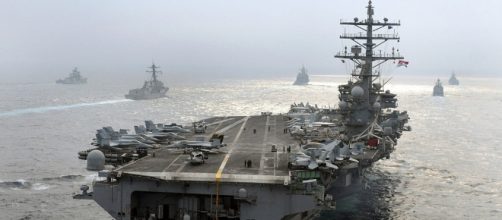The US Navy has taken a bold action this week. The Navy has sent its USS Ronald Reagan carrier strike group off the coast of the Korean Peninsula, just near North Korea. The forward-deployed supercarrier along with some warships will be joining a huge naval and air exercise, which will take place off the coast of the Korean Peninsula.
According to Sputnik News International, the US Navy has just sent one of its biggest warships on a naval drill near the North Korea, in a show of a brute force designed to warn off North Korea from taking any potential military strikes against the United States and its allies.
The massive naval and air force exercise will take place before the US President’s official visit to Asia. US President Donald Trump is slated to take its official visit to Asia on November 3 to November 14. During this official trip, the US President will make some stops in the Asian countries of Japan, South Korea, Vietnam, the Philippines and archrival country China. Trump will also make a stop on the island of Hawaii.
Joining the supercarrier USS Ronald Reagan will be a plethora of warships, which include the forward-deployed Arleigh-Burke-class destroyer USS Stethem. Rear Admiral Marc Dalton heads the US Navy's carrier strike group, the Business Insider reported.
About the American supercarrier
Built by Northrop Grumman Newport News and launched in March 2001, the USS Ronald Reagan is a 100,000-ton Nimitz-class, nuclear-powered supercarrier. Its one of the most advanced and biggest warships in the US arsenal.
The 332-meter supercarrier has a crew of 5,000 sailors and has around 90 fixed-winged aircrafts and helicopters.
It can reach a top speed of around 30 knots (35 mph) and has an unlimited range, thanks to its two Westinghouse-built A4W nuclear reactors. The nuclear power also means that the carrier can go anywhere in the world.
As for the carrier’s main armament, the Ronald Reagan’s arsenal includes the highly lethal Evolved Sea Sparrow missile and Rolling Airframe Missile.
It also includes a close-in weapon system called the Phalanx CIWS, which provides an additional layer of protection for the carrier. The carrier primarily used the Phalanx CIWS for detecting and destroying short-range incoming missiles and enemy aircrafts.
Additionally, the carrier also includes a number of electronic countermeasures and decoys, which have been designed to defeat enemy’s radars and missiles. These include the Navy’s AN/SLQ32A(V)4 countermeasures suite and SLQ-25A Nixie Torpedo countermeasures.
North Korea continues its missile tests
Pyongyang has been beefing up its nuclear arsenal in the past months. The rogue nation has launched a series of missile tests, including the two missile launches over Japan.
Unfortunately, for the US and its allies, the regime still has no plans to stop its weapon test.
As mentioned earlier by Business Insider, North Korea is readying for another missile test, which many experts believe can reach the US mainland. The UN Security Council has already imposed economic sanctions on North Korea over its nuclear weapon development program. These include a ban on raw materials and seafood exports.


